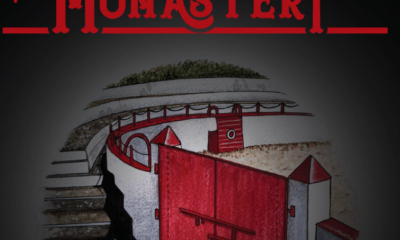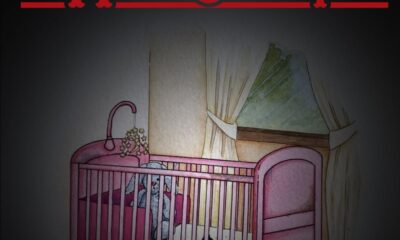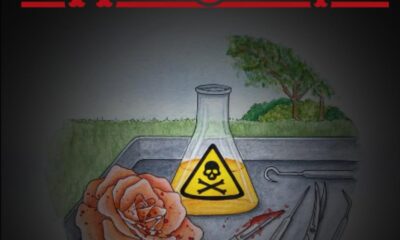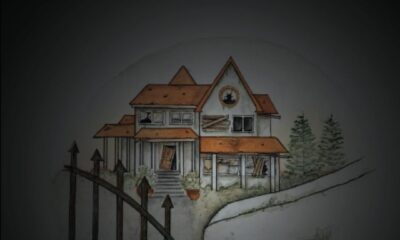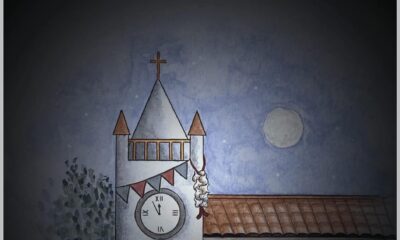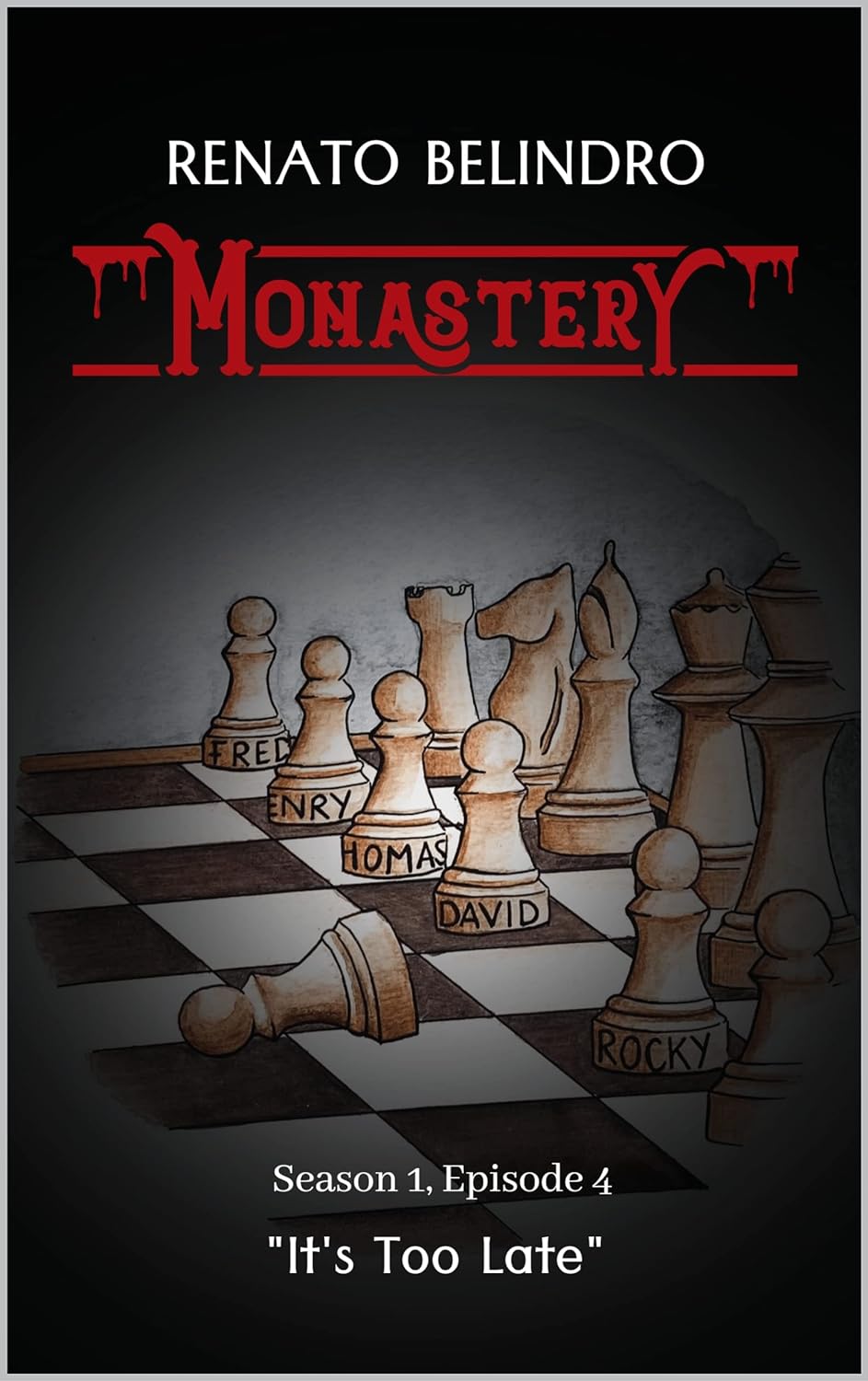
Monastery Series 4: a Book Review
Here we are once again with yet another installment of Monastery. I’ve said it before but with every part, the emotional stakes are rising in a tidal wave-like motion. We experience so many feelings as readers – excitement, fear, and heartbreak to name a few. Without any further ado, let’s take a dive (pun intended) and see where this chapter takes us, shall we?
Plot
We start with a nightmare sequence that’s something straight out of a horror movie. It’s revealed this is one of Henry’s recurring dreams (cheers to Cassandra for continuing the generational trauma chain). Our main group continues the investigation, still trying to get to the bottom of Albert’s murder. The only thing they find out is how much they don’t know, which is not helpful in the slightest.
The love triangle between Nicole, Fred, and David continues as Nicole confides in David’s mother about whom she should choose. It’s an interesting representation of what both guys stand for and what they can offer Nicole. Although in love triangles the person who is stuck between two people is often hated by fans (The Vampire Diaries, anyone?), I think it’s done really well in Monastery. After all, it’s just a group of young people trying to figure out their feelings. Sadly, in this situation, someone was always going to get hurt. David does not take the rejection lightly, which made my heart ache for him. I do wonder if that’s the end of this storyline.
Francis is taking his competition for the most unsettling character with Cassandra very seriously. It’s clear he has a lot of seething hatred for his family, including his nephews and I’m actually concerned for their safety. That’s not to say I’m not intrigued as to why he’s acting this way. His altercation with Fred, followed by Cassandra’s revelation that she doesn’t want Fred around is yet another tearjerking moment. It must be horrible to feel like you have no actual loving home, which puts a new layer on his relationship with Nicole.
No one could argue the ending is where the real turning point of the story is. Thomas’s interrogation of his older family members ends up in a tragic death, or so he thinks. Let’s just say that the neighborhood bully has become a lot more integral to the plot. Regardless, I can’t help feeling horrible for Thomas. Sure, he got a bit into his head trying to get answers and forgot to consider other people’s feelings. However, every mystery needs a character with a sense of justice, otherwise it would never be solved. I do hope the truth about the incident comes out sooner rather than later, for everyone’s sake.
Overall thoughts
The fourth part of Monastery really toys with your emotions in the best way. If we don’t care for our characters, what’s the point in following the story? I felt genuine sadness for these people while reading and while this tonal shift at this point in the book is necessary, it doesn’t make it any less painful. I wish I could give them all a big hug and shield them. Alas, the mystery is nowhere near being solved and something tells me there’s a lot more heartbreak ahead…
 (5 / 5)
(5 / 5)
Read below for more insights from the author:
- It’s safe to say this was the most heart-wrenching episode of Monastery so far. Out of all the sad moments, which one was the hardest for you to write and why?
I love writing big, dramatic scenes – the bleaker, the better! So, I’m going to comment on the one that was harder to write from an operatic perspective, not an emotional one. Nana Beth’s reveal at the end was the hardest simply because all of the protagonists are there. When you have five kids at odds with each other, it’s difficult to ensure every one gets a word in and that you can still tell them apart. Additionally, I wanted to build up to the reveal in a way where you don’t see it coming straight away but it’s also not a curveball.
- Do you have a favourite adult character to write for (excluding Albert and Cassandra) and if so, who? Similarly, is there an adult character that’s hard for you to write but you need to cause of the plot?
I adore Maggie. It’s no secret that the Keane family draws inspiration from my own, so Maggie of course borrows heavily from my mum. I love how she is essentially everyone’s mother figure, not just David’s – she is a boss lady whose only fear in life is not being able to protect the ones she loves.
On the flip side, I hate writing for George Turner – he is written to be disgusting, of course, and he is perfectly satirical of the kind of small-minded, middle-aged men you may find in less populated areas. But he just doesn’t flow out of me the way most characters do.
- Lastly, can you share anything at this point in the story about Francis’s motivations for acting how he is? For me personally, he is currently the most unsettling character (which is saying a lot considering Cassandra is right there!).
Funny little segue here, as episode 5 (the midseason finale) is a massive one for both George and Francis, two of the villains in the plot. We find out a lot about what drives Francis and what makes him tick, and just how unsettling he can be. There is a lot of resentment pent up within young Francis, and when it finally erupts, you don’t want to be anywhere near it. As for what caused said resentment, there is an origin story a-comin’, and it’s the soapiest episode of Monastery yet. Stay tuned!
Book Reviews
A Stellar Debut Novel, We Used To Live Here
Imagine this. You’re home alone, waiting for your partner to return, when you hear a knock on your door. You answer it to see a family of five, bundled up against the cold. The father, a kindly older gentleman, explains that he used to live in this house as a boy. And he would love to show it to his family.
Do not let them in.
The story
Released in June 2024, We Used To Live Here is author Marcus Kliewer’s debut novel. It tells the story of Eve, who just purchased a beautiful house with her partner, Charlie. Their plan is to flip the house and sell it.
One night, while waiting for Charlie to come home, Eve is surprised by a knock at the door. It’s a man named Thomas Faust and his family.
Thomas explains that he grew up in the house and hasn’t been in the area in years. Would Eve let them in so that he can show the home to his children?
Against her better judgment, Eve lets them in. She regrets this almost at once when Thomas’s daughter vanishes somewhere into the house.
What worked
I always appreciate a book that allows you to play along with the mystery. And this book does that better than just about any other I’ve seen.
Pay close attention to the chapters, to the words that aren’t there. To everything about this novel.
This is mostly down to Kliewer. This is ultimately his work of art. But the production value is also fantastic. I don’t want to ruin the multiple mysteries, so I’ll just say this. There are clues in this book that require some specific artistic choices in the page layouts in this book. And I loved that.
If you’d like to experience another horror book review, check out this one.
We Used To Live Here is also the kind of story that makes you question everything right along with the main character, Eve. Eve is a great main character. But she might be an unreliable narrator. She might be experiencing every single horror described, exactly as it’s described. Or, she might be having a psychotic breakdown. Through most of the book, we can’t be sure. And that is so much fun.
Finally, the weather plays a large part in this story. There are several stories in which the weather or the land itself could be considered a character. Even an antagonist. This is certainly one. The winter storm is the thing that traps the family in the house with Eve. It also makes escaping the home difficult. Reading this book during the winter was especially impactful. Most of us know what it feels like to be shut in by a storm. I’ve personally lived through some of those storms that are just referred to by their year, as though they were impactful enough to claim the whole 365 days for themself. And that was with people I liked. Imagine what it would feel like with strangers. It’s a staggering thought and one that we explore in depth in this book.
- Get Out meets Parasite in this eerily haunting debut and Reddit hit—soon to be a Netflix original movie starring Blake Lively—about two homeowners whose lives are turned upside down when the house’s previous residents unexpectedly visit
- As a young, queer couple who flip houses, Charlie and Eve can’t believe the killer deal they’ve just gotten on an old house in a picturesque neighborhood
- As they’re working in the house one day, there’s a knock on the door
Last update on 2025-03-08 / Affiliate links / Images from Amazon Product Advertising API
In the end, We Used To Live Here is a fantastic book. It’s the sort of story that sneaks into your brain and puts down roots. And if this is just the first book we’re getting from Kliewer, I can’t wait to see what else he comes up with.
 (5 / 5)
(5 / 5)
Book Reviews
Exploring real terror with The House of My Mother
As a disclaimer, this is a review of The House of My Mother from a critical perspective. I will not be discussing my opinions of the legal case against Ruby Franke and Jody Hildebrandt. I will be discussing the merits of the book as a work of true crime alone.
In 2015, Ruby Franke started a YouTube channel called 8 Passengers. In August of 2023, Franke and her business associate Jodi Hildebrandt were arrested for, and later plead guilty to, charges of aggravated child abuse. And in January of this year, Shari Franke told her story in The House of My Mother.
The story
The House of My Mother is the true story of Shari Franke, the oldest child of one of the most famous family vlogger families.
As a child, Shari came to the conclusion that her mother didn’t like her. Soon, she began to fear her mother’s anger.
Things got significantly worse when Ruby started their family vlog. All of the families most intimate moments were splashed across the internet for anyone to watch. This became a living nightmare for Shari.
Of course, that was only the start of the family nightmare. Because Ruby was about to meet someone who would reinforce all of the darkest parts of herself.
Eventually Shari manages to escape her home. But her younger siblings were still in her mother’s clutches. She had to save them, and her father, from the monster her mother had become.
What worked
Through the book, Shari only ever mentions the name of one of her siblings, Chad. This is because Chad is the only of her siblings that is an adult at the time of the publication.
There are children involved in this story. Children who’s lives and privacy have already been damaged. Shari didn’t want to do that to them again, and neither do I.
It probably won’t surprise you that this book is full of upsetting details. But not in the way you might imagine.
Nowhere in this book will you find gory details about the abuse the Franke kids suffered. And I consider that a good thing. Those sort of details are all fun and games when we’re talking fiction. When it’s real kids who are really living with the damage, it’s not a good time.
What you’ll find instead is a slew of more emotionally devastating moments. One that stuck with me is when Ruby’s mother gives her a pair of silk pajamas as a gift after Ruby gave birth to one of her babies. Shari asks Ruby if she’d bring her silk pajamas when she had a baby. Ruby responds that yes, when Shari becomes a mother they can be friends.
What a lovely way to make a little girl feel like she’s not worth anything unless she reproduces. And, if she does decide to have children, who is going to bring her silk pajamas?
- From eldest daughter Shari Franke, the shocking true story behind the viral 8 Passengers family vlog and the hidden abuse she suffered at the hands of her mother, and how, in the face of unimaginable pain, she found freedom and healing
- Shari Franke’s childhood was a constant battle for survival
- Her mother, Ruby Franke, enforced a severe moral code while maintaining a façade of a picture-perfect family for their wildly popular YouTube channel 8 Passengers, which documented the day-to-day life of raising six children for a staggering 2
Last update on 2025-03-02 / Affiliate links / Images from Amazon Product Advertising API
In the end, this isn’t a story about ghosts or demons. It’s not about a serial killer waiting on a playground or in the attic of an unsuspecting family. Instead, this is a story about things that really keep us up at night. It’s the story of a woman so obsessed with perfection that she drove away her eldest daughter. The story of a young woman who’s forced to watch from afar as her beloved brothers and sisters are terrorized and abandoned. These are the sorts of things that really keep us up at night. These are the real nightmares.
More than that, though, The House of My Mother is a story of survival. It’s about a family that was ripped apart and somehow managed to stitch itself back together again. It’s about a brave young woman who managed to keep herself safe and sane in the face of a nightmare. If you haven’t read it yet, I can’t recommend it enough.
For more like this, check out my review of Shiny Happy People.
 (5 / 5)
(5 / 5)
Book Reviews
Book Review of Boreal: an Anthology of Taiga Horror
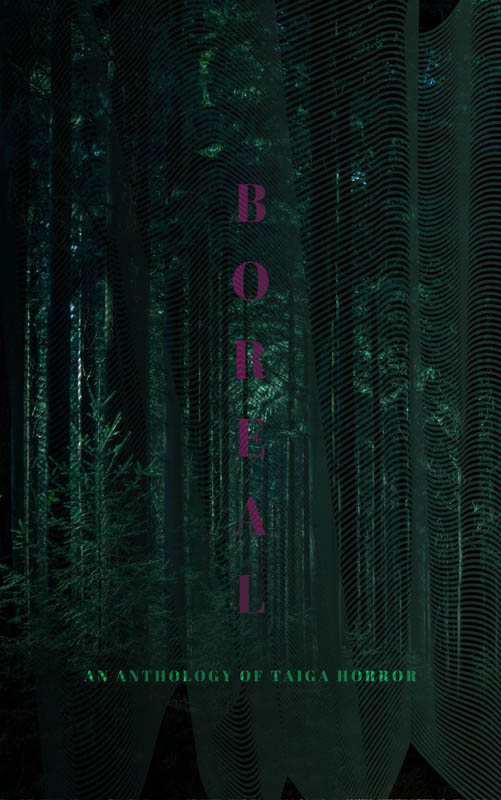
Boreal: an Anthology of Taiga Horror is a collection of twenty-two haunting tales that dwell in the deepest darkest woods and frozen wastelands, edited by Katherine Silva and including Haunted MTL’s very own Daphne Fauber. Each story has even been gifted with its very own poster, hinting at the horrors to be found within it, bestowing a beautiful visual collection as well.
The tales are varied and touch upon the environment in new and different ways, each hearkening to a sort of epiphany or raised awareness. These stories exude both dread and wonder at the smallness of our human existence in contrast to the sacred world we have isolated from, sheltering ourselves in our comfortable houses with centralized heat and everything we could possibly need or want at the ready. The taiga becomes a sanctuary outside of our own dulled awarenesses. It is a holy place imbued with powers beyond mortal human reach, a wilderness that threatens to swallow us – both whole and bit by bit, simultaneously.
The protagonists enter into this realm through ritual, superstition, longing, stubbornness, and their own hubris – yearning to survive its dangers, and to make their own marks upon it. The starkness of their surroundings harbors delicate moments that would be all too easily missed if not deliberately sought or pointed out. The softness of fur, the dappled sunlight shining through trees, the hazy clouds of breath forming in crisp air, the brittleness of bleached bone… those quiet experiences that beg to be forgotten, to lay safely sleeping just below the frozen surface, awaiting spring.
There are those who followed in the footsteps of their predecessors, seeking to escape the constraints of their parent’s and elders’ indoctrination, traditions, madness, and abuse, yearning to find their own way despite also being inextricably bound to their own pasts. There are those who just wanted to go for a walk in the woods, and remained forever changed by what they experienced. There are those who wished to impose their will upon the wilderness, their order falling to disarray, unable to make lasting impact. There are those who sought to leave behind the world of mankind, looking for oneness in the natural order of things through isolation, leaving a bit of themselves behind after being consumed by the terrors they encountered. There are those who truly found communion with the woods, became one with its wildness, and invited its spirit into their hearts to find peace, even at cost of their own lives. And then, there are the spirits themselves…
 (3 / 5)
(3 / 5)
All in all, I give Boreal: an Anthology of Taiga Horror 3.0 Cthulhus. I love existential angst so I found it to be an enjoyable read, and I appreciated the myriad manners in which the biome was explored. But there were points in which I found myself struggling to follow along, as if the words were swept up into their own wilds in ways that alienated myself as reader, as if my mere voyeurism into this otherworldly place was not enough to comprehend the subtle deviations in storytelling mannerisms fully. I suppose in some sense this seems appropriate, but at the same time, it left me feeling a bit unfulfilled, as if I had missed a spiritual connection that should have resonated more deeply.
- English (Publication Language)
- 248 Pages – 02/25/2025 (Publication Date) – Strange Wilds Press (Publisher)
Last update on 2025-01-23 / Affiliate links / Images from Amazon Product Advertising API


